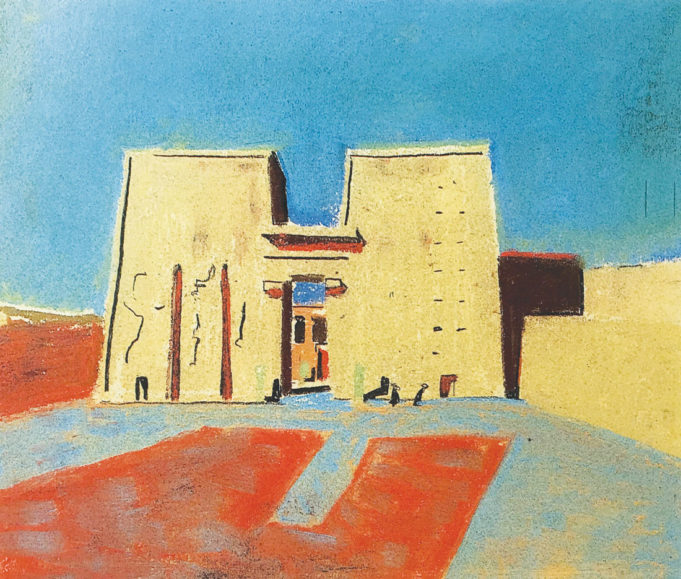Since the Kimbell Art Museum opened its doors in 1972, its galleries have hosted (in addition to the museum’s incomparable permanent collection) some of the world’s most sublime and superlative artworks. Whether Matisse and Picasso, J.M.W. Turner, or the treasures of the Barnes Foundation, the Kimbell has garnered a reputation as a place where great art can look its best. Thanks to the masterful understanding of light and shadow held by its architect, Louis Kahn (1901-1974), the Kimbell is widely considered to be one of the finest museum buildings anywhere, and helped secure Kahn’s legacy as one of the past century’s greatest builders.
The Kimbell is now hosting two exhibits that feature the work of its own architect. Louis Kahn: The Power of Architecture and The Color of Light, The Treasury of Shadows: Pastels by Louis I. Kahn from the Collections of His Children run through June 25. For the former, Fort Worth is the second to last stop for this comprehensive exhibit of the architect’s work, and the only occasion to view the exhibit in one of Kahn’s own buildings. Organized by Germany’s Vitra Design Museum in cooperation with the Netherlands Architecture Institute and the Architectural Archives of The University of Pennsylvania, it is the most significant touring exhibition of Kahn’s work since Louis I. Kahn: In the Realm of Architecture, which visited the Kimbell in 1993.
For those fortunate enough to have attended the previous exhibit, many of the models from Penn’s Architectural Archives will be familiar, looking hardly the worse for the ensuing 24 years. Kahn taught at the University of Pennsylvania from 1957 to 1974, and it is hard to imagine an exhibit of his work that didn’t include the Architectural Archive’s essential contributions. Kahn’s studio models for the National Assembly Building of Bangladesh in Dakha and the Phillips Exeter Academy Library, in particular, display a level of intricacy and craftsmanship rarely seen in the age of computer-aided modeling. These models are large enough and cut away in such a manner as to allow visitors to experience the interior volumes of Kahn’s buildings in a way that photographs or computer rendering simply cannot.
Vitra has commissioned new models of Kahn’s work for the exhibition as well, notably a 12-foot tall model of City Tower (1952), an unbuilt project for the city of Philadelphia that Kahn designed with his associate Anne Tyng. Tyng was a brilliant theoretician and designer whose contributions to Kahn’s practice have all too often been overlooked. One of the great strengths of the Vitra exhibit is that many of Kahn’s quiet collaborations have been given the recognition they deserve.
The exhibit is organized in seven sections, the first being a biographic overview, and the other six devoted to various thematic areas: City, Science, Landscape, House, Eternal Present, and Community. Vitra has again contributed new models of some of Kahn’s residential work, as well as a full-size replica of a window with seating from the Fisher House (1967). Each section, though supplemented with video or other media, is grounded in the tactile, the material, and the tectonic. Each section introduces and credits Kahn’s influences and collaborators, from his friend Buckminster Fuller to his longtime engineer August Komendant to landscape architect (and mother to his son, filmmaker Nathaniel Kahn) Harriet Pattison.
Kahn’s significant projects were mostly designed during the last 20 years of his life, and the exhibit takes care to show the process by which the architect arrived at the ideas that informed his buildings. Whether describing the nature of the city, the integrity of structure, or the choreography of sunlight, Kahn’s words are one with his work.
Perhaps the most moving pieces of the exhibit pertain to Kahn’s memorials. One, unbuilt, commemorates the Jewish martyrs of the Holocaust in a series of seven translucent cubes. The other, the Franklin D. Roosevelt Four Freedoms Park in New York City, was finally completed in 2012. However, by the time the exhibit concludes at the National Assembly Building of Bangladesh, visitors will perhaps be most impressed that Lou Kahn, the shy, scarred, enigmatic Jewish immigrant born in the Russian Empire, would come to build the magnificent Capitol building (and mosque) of a young Muslim nation — enshrining democracy through architecture.
The small display of pastel sketches of The Color of Light, The Treasury of Shadows: Pastels by Louis I. Kahn from the Collections of His Children is a separate but concurrent exhibit of Kahn’s work from a three-month period in 1950-1951 while he was Architect in Residence at the American Academy in Rome. Kahn’s three children — musician Sue Ann Kahn, artist Alexandra Tyng, and filmmaker Nathaniel Kahn — each contributed from their personal collections of their father’s work.
For all the Vitra exhibit’s intellectual heft and tectonic poetry, there is an experiential quality to Kahn’s work and his sensibility that the best research and the most beautiful basswood models cannot hope to communicate. To a significant extent, this sensibility can be understood through the architect’s own sketches from this formative time in his development — when, at 50 years of age, he was about to embark on the most prolific and significant period of his career.












